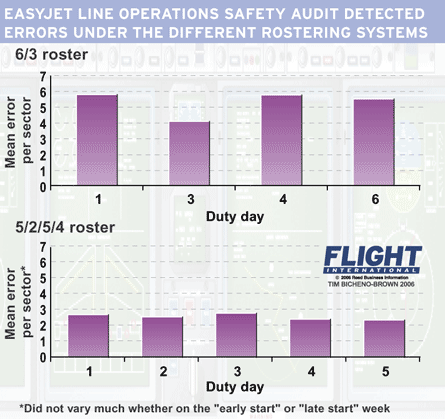EasyJet’s original pilot roster was six days on, three days off, and it complied with the flight time limitations (FTL) laid out in UK Civil Aviation Authority regulation CAP371. But the six days on duty had to be split into two parts because CAP371 does not allow – as European FTL regulation does – five early-start duties in a row. So the six duty days began with three early shifts, then switched to three late shifts.
 |
Phase 1 of the airline’s trial concentrated on measuring crew performance on the 6/3 roster using a human factors monitoring programme (HFMP) assisted by specialist organisations like NASA, Boeing, Interdynamics, AWAKE and the UK universities of Cranfield and Loughborough. Throughout the study EasyJet operated a threat and error detection methodology developed by the University of Texas, says director of safety and security Capt Peter Griffiths.
Crew performance and fatigue symptoms were measured using different methods and from various contrasting angles. These included: demographic, crew resource management (CRM) and attitude surveys of the pilot population; an activity watch and a sleep diaries study; flight data monitoring (FDM) and safety data analysis; pilot air safety reports analysed using the British Airways Safety Information System; line operations safety audits; predictive fatigue modelling; archive crew duty hours, sickness rates and crew turnover rates; and roster stability data.
EasyJet’s summary of the Phase 1 findings was that the 6/3 roster was associated with “unacceptable levels of operational risk”, despite the roster being acceptable under CAP371. The FRM (fatigue risk monitoring) trial run in Phase 2 was designed to eliminate the “disruption of circadian rhythms” represented by the three early shifts followed by three late shifts in the same duty week, which affected performance. So EasyJet proposed the roster it is running today: five early days followed by two days off; then five late shifts followed by four days off.
 |
The CAA accepted the findings of Phase 1, and gave permission for Phase 2 to begin, using the 5/2/5/4 formula and involving 350 EasyJet pilots. It has worked, the airline says (see bar chart comparisons). “A survey indicated that 93% of pilots stated they felt less fatigued under the new roster,” says the summary report of the Phase 2 study, continuing: “The results indicate that a mitigation of shift lag effects and a reduction in consecutive duty days worked has led to enhanced operational performance.”
As a result, the report says, the CAA gave EasyJet “a permanent alleviation to work outside FTL [by adopting the 5/2/5/4 pattern] at all 14 company bases.” But the CAA has not finished yet, says flight standards officer Derek Brown. There are other anomalies that became apparent and are being examined, including performance and fatigue differences between pilots working at different bases.
Pilots based at London Gatwick particularly, and to a lesser extent the other London area airports, showed greater fatigue-based performance loss than pilots based elsewhere. Griffiths says the study found that Gatwick-based pilots tend to live further from the airport, and are more likely to experience “hassle factors” like traffic jams and parking problems travelling to work and, once in the aircraft, the tighter slot demands and longer taxi times add to the stress.
 |
Air traffic control-related workload in complex and congested airspace is a factor, says Griffiths: “Hours create tiredness; other factors and workload produce fatigue.” He is now working with crews and the CAA “to identify the hassle factors that really matter to see if we can mitigate them”. Brown thinks the factors may be sufficient to warrant running different rosters at the London bases – 5/3/5/4 instead of the now accepted 5/2/5/4. This is not decided yet, and the trial goes on.
Today EasyJet and the CAA are examining new ideas based on lifestyle factors as well as duty hours and workload. What pilots do at home makes a major difference to their effectiveness at work, and their off-duty activities are affected by “where they are in their life cycles”, says Griffiths – whether they are young or middle-aged, single or married, and whether they have young children.
“Instead of having a one-size fits all system,” Griffith says, tools could be developed to enable pilots to vary their work/life balance, with remuneration reflecting what they choose. Meanwhile, he says, flightcrew will soon be presented with a fatigue-risk management manual “to help them identify risks they can manage themselves”.
Source: Flight International
















